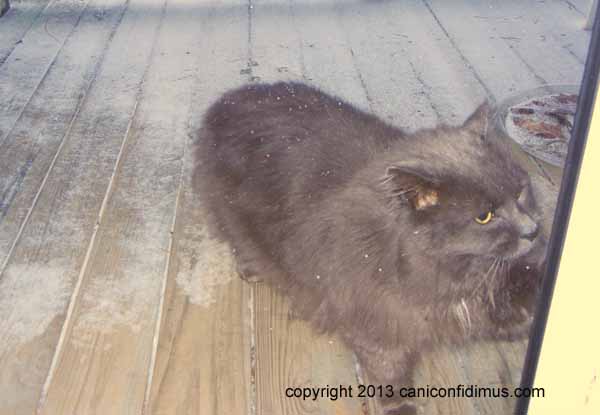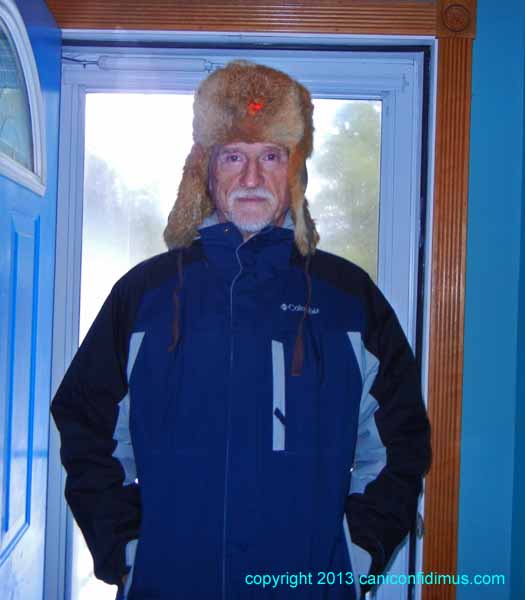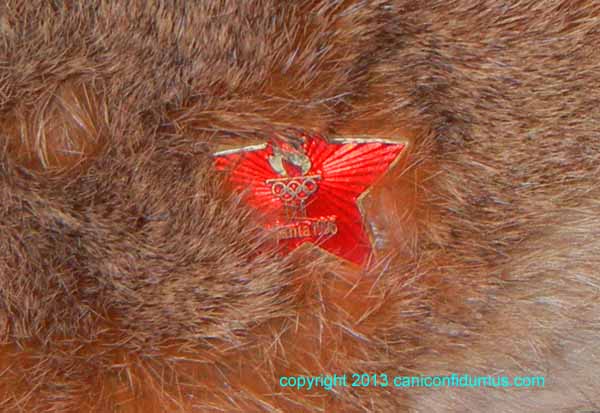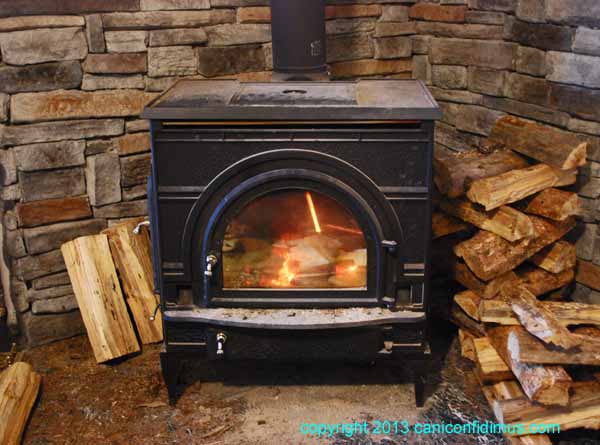It was 23 F when we got up Monday morning. It’s already been colder this winter, but this is the first time the Atlanta TV weather forecasters have been so excited (“The polar vortex is coming! Run! Run!”). The temperature slowly dropped all day.
Leah was worried about the cats Sunday night, so we let Zoe, Smokey and Sylvester stay inside in addition to Chloe, who has been staying in since it got cold. But nature calls, so we put them out for a while in the morning.
Smokey did not like it.

Let me in
With the wind, it felt much colder than 23, so I thought Monday morning when I walked the dogs around the house it would be a good time to wear my LL Bean fur cap. My brother gave it to me a long time ago when he lived near Pittsburgh, but I haven’t had a good excuse to wear it until now. Plus I lost it for a while.

I was not as unhappy as I look here
If you look closely you can see the red star from the Russian pin I got at the 1996 Atlanta Olympics. I think it fits the cap.

Russian star
The dogs wore their winter coats when I took them out Monday morning. I didn’t take either of them for their usual long walk, but I did take Zeke for a shorter one. I left Lucy inside; small dogs lose heat faster than big dogs. We had a little snow overnight, and there were still a few flakes floating around when we walked. They were small and glittering, and they seemed to float more than fall. When a little breeze stirred them, they all took off in the same direction like a flock of birds.
Monday night was even colder. It was 6 F when we got up this morning (Tuesday). The dogs got two short walks around the house for purposes of nature calls, but only Zeke will get a longer walk, and he’ll have to wait till this afternoon when the temperature is supposed to reach 26. The cats, of course, stayed in Monday night, too. Unfortunately, Rusty and Dusty won’t come in, so they had to rough it in the cathouse or somewhere in the garage. I hope Dusty didn’t spend the night in a culvert.
The very low (for us) temperatures are an opportunity to see heat transfer at work. As you all know, wind chill is a great favorite of weather forecasters. One of the Atlanta guys said that it only refers to effects on humans, and that is partially correct. If the temperature is 35 with a wind chill of 20, a human will feel very cold without a coat, but a glass of water still won’t freeze. On the other hand, if it’s 6 F with a wind chill of -20 F, a house will lose heat much more quickly than it would in still air. We saw that last night. We (and by “we” I mean “I”) kept a fire going in our wood-burning stove all night, getting up twice to feed it. The stove kept the basement at around 77, but our bedroom dropped to 68 and the bathroom dropped to 66. Ice formed on the sliding glass doors with aluminum frames. And even with the stove going, our heat pump came on several times Monday night. Under more normal conditions, the stove alone will keep the house warm enough that the heating system doesn’t come on. Six degrees and wind removes too much heat from the house for the stove to keep up with it. At these temperatures a heat pump relies almost entirely on resistance heating, which is going to show up in our power bill.
The house complained about the temperature. The deck on the back and the front walk popped and banged all night as the wood shrank and rearranged itself.
This morning dawned clear. The sun is struggling to warm our bedroom and the living room, but I expect by afternoon the combination of the sun and the stove will have warmed the house enough that Leah can take off her anorak and mukluks.
These temperatures are not especially low for many places in the US, but they are for Georgia. Significant winter weather events are rare in Georgia. I remember them by their stories.
The first winter storm I remember was an ice storm in 1959 or 1960, when I was in elementary school. Rain fell onto cold surfaces and froze into a solid, glass-like coat. All night long we listened to the pine branches snapping off. They sounded like gunshots. The limbs fell onto power lines that were already sagging from their own ice coating, and the lines broke. We lost power for a long time. Our house was heated with a floor furnace, and, of course, the thermostat didn’t work without electricity. But my father went under the house and managed to get the furnace to run steadily without electrical power. I think we were the only ones on our street with heat.
The next I remember was a cold snap a few years later that happened after a lot of rain had caused the streams and rivers to flood. Ice formed on the on the flooded creek where my father took my brother and me and our dog Mike for a walk. Mike went out on the ice and fell through. We heard him barking. We went down to the edge of the ice and called and called. He struggled, putting his front feet on the ice and trying to haul himself out, but every time he got up, the ice broke under him. He finally pulled himself out. I don’t know what would have happened if he had not been able to get out. My father would not have gone after him and left us there, and he certainly never would have let us go after him. I know what I would do today if it happened with Zeke or even Lucy.
The next one was the winter of 1984-1985, when I was in graduate school at Georgia Tech. I lived in a small apartment at the back of a house two blocks from Northside Drive and about two miles from school. When I drove back to my apartment after school, the snow was coming down in hard little balls, but the streets were clear. As I always did, I took my dog Jesse to a field across Northside, where I let her run for a half hour or so. By the time I had changed my clothes and walked the two blocks to Northside, cars were sliding sideways down the hill. The storm hit so quickly that some of the faculty in the Atmospheric Sciences Department were caught by surprise and had to spend the night at school.
Later that evening I was watching TV when my roommate, an undergrad, came in with a young female student. The girl stayed a few minutes and then said she was going to her apartment. I thought she had driven my roommate home, but I finally put two and two together and asked him if they had walked from campus. When he said they had, I said we couldn’t let her try to walk home. She was planning to walk about 10 miles out beyond the perimeter road through the snow in a dress and open shoes. That’s when I came up with my first rule of life: Never wear shoes you can’t walk home in.
We got into my little Honda station wagon and started out. By that time the roads were nearly impassible, and what was passable was usually blocked by cars driven by idiots. We spent about two hours finding a way out to the girl’s apartment, going first one way, and then another. The snow was already so deep that at one traffic jam I turned around in a parking lot and drove over the curb without realizing it.
When we let the girl out at her apartment, I think she said thanks.
This weather is severe, but I don’t think I’ll have a story for it. It’s just cold, and the stove is warm.

![]()